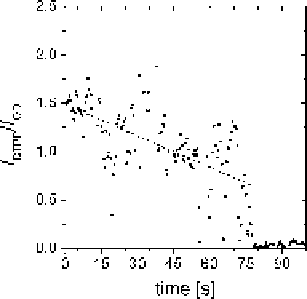Biomedical Engineering Reference
In-Depth Information
Fig. 4.19
Luminescence
intensity ratio
R
I
DTPP
/
I
QD
as a function of observation
time for “QD-DTPP”
nanoassemblies in TEHOS
=
be assigned to one of the rare blinking events of DTPP. The overall interpretation is
that the PL of the QD is quenched due to FRET according to QD
→
DTPP and that
DTPP fluorescence is predominantly caused via FRET.
Alternative to FRET, intensity correlation might be caused by photoinduced
electron transfer from the QD to DTPP. In that case both constituents are charged
and at least the luminescence of DTPP will be completely quenched. However, such
an explanation can be ruled out because of the intrinsic nature of QD blinking which
does not change upon aggregate formation. If charge transfer would apply, the PL
of the dye will increase when the QD is “off” and cannot act as a charge donor.
To obtain a more quantitative description of FRET we have plotted the lumi-
nescence intensity ratio
R
I
DTPP
/
I
QD
in Fig.
4.19
. It is seen that the correlation
clearly depends on the observation time and changes by more than a factor of 3. A
detailed analysis (with normalized intensities for each constituent) shows that the
linear correlation of intensities is quite constant during the first 30 s, but changes in
the course of time. This can be interpreted as being due to time-dependent changes
of the geometry of the assembly or the conformation of DTTP.
From the quenching data of the donor (QD) PL intensity
I
QD
in the single “QD-
DTPP” nanoassembly, FRET efficiency can be calculated according to [
139
]tobe
=
I
QD
-
DTTP
I
QD
E
FRET
=
1
−
.
(4.9)
It is seen from Fig.
4.18
b that DTPP is photobleached for times longer than 77 s.
Taking the maximal PL intensity
I
QD
in that range and the maximum of the intensity
I
QD-DTTP
during the time DTPP is not photobleached (Fig.
4.18
c) we obtain
according to Eq. (
4.9
)
E
FRET
≈
0.69. This can be compared to the situation at 57 and
72 s when DTPP is “off” due to blinking providing
I
QD
and compare it to
I
QD-DTPP
when DTPP is “on” again. According to Eq. (
4.9
) this results in
E
FRET
≈
0.55. Both
≈
values are in reasonable agreement with
E
FRET
0.85 calculated within Foerster
model [
94
] (see Sect.
4.2.2.2
).

